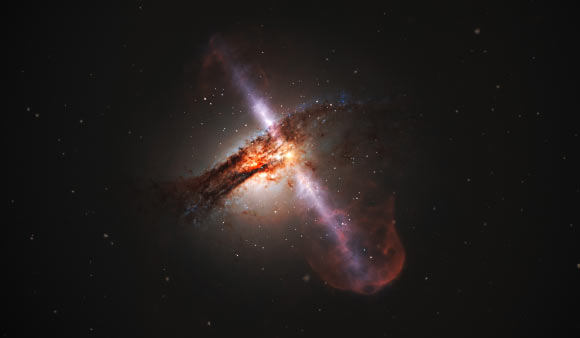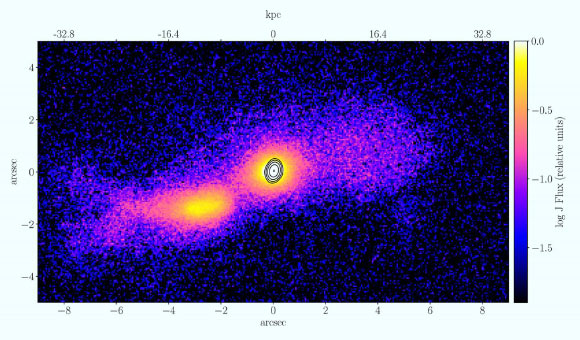Astronomers Observe Relativistic Jet from Two Merging Spiral Galaxies | Astronomy – Sci-News.com
Astronomers using the 8.2-m Subaru Telescope report the first unambiguous detection of a relativistic jet — a beam of charged particles that travels at nearly the speed of light — emerging from two colliding spiral-shaped galaxies.

This artist’s impression illustrates how high-speed jets from supermassive black holes would look. Image credit: NASA / ESA / Hubble / L. Calçada, ESO.
Jets are the most powerful astrophysical phenomena in the Universe. They can emit more energy into the Universe in one second than our Sun will produce in its entire lifetime. That energy is in the form of radiation, such as intense radio waves, X-rays, and gamma-rays.
Jets were thought to be born from older, elliptical-shaped galaxies with an active galactic nucleus (AGN), which is a super-massive black hole that resides at its center.
Astronomers theorize that the AGNs grow larger by gravitationally drawing in gas and dust through a process called accretion. But not all of this matter gets accreted into the black hole. Some of the particles become accelerated and are spewed outward in narrow beams in the form of jets.
“For the first time, we have found two spiral- or disk-shaped galaxies on path for a collision that have produced a nascent, baby jet that has just started its life at the center of one of the galaxies,” said lead author Dr. Vaidehi Paliya, a researcher with the Deutsches Elektronen Synchrotron (DESY).
Other teams of astronomers have already imaged galactic collisions many times. But Dr. Paliya and colleagues are the first to capture two galaxies merging where there is a fully formed jet pointing at us — albeit, a very young one, and thus not yet bright enough to blind us.
“Typically, a jet emits light that is so powerful we can’t see the galaxy behind it,” said senior author Professor Stefano Marchesi, an astronomer in the INAF — Osservatorio di Astrofisica e Scienza dello Spazio di Bologna.
“It’s like trying to look at an object and someone points a bright flashlight into your eyes. All you can see is the flashlight. This jet is less powerful, so we can actually see the galaxy where it is born.”
“Active galaxies which have jets are usually big, old elliptical galaxies which, according to the models, are formed by the merger of two or more smaller galaxies, so that we think that these mergers are the cause of the activation of the jets,” said co-author Dr. Rubén García-Benito, a researcher at the Instituto de Astrofísica de Andalucía (IAA-CSIC).
“A collision is a very efficient way to make large masses of gas fall to the centre of a galaxy, which feeds the supermassive black hole and can produce the emergence of the jet.”

TXS 2116-077 (seen on the right) collides with another spiral-shaped galaxy of similar mass, creating a relativistic jet in the center of TXS 2116-077. Image credit: Paliya et al, doi: 10.3847/1538-4357/ab754f.
The team used the Subaru Telescope to capture two galaxies: a Seyfert 1 galaxy called TXS 2116-077 and a Seyfert 2 galaxy of similar mass.
They performed subsequent observations with the Gran Telescopio Canarias and William Herschel Telescope, as well as with NASA’s Chandra X-Ray Observatory.
They believe that the galaxies were colliding for the second time because of the amount of gas seen in the image.
“Eventually, all the gas will be expelled into space, and without gas, a galaxy cannot form stars anymore,” Dr. Ajello said.
“Without gas, the black hole will switch off and the galaxy will lay dormant.”
The findings were published in the Astrophysical Journal.
_____
Vaidehi S. Paliya et al. 2020. TXS 2116-077: A Gamma-Ray Emitting Relativistic Jet Hosted in a Galaxy Merger. ApJ 892, 133; doi: 10.3847/1538-4357/ab754f






